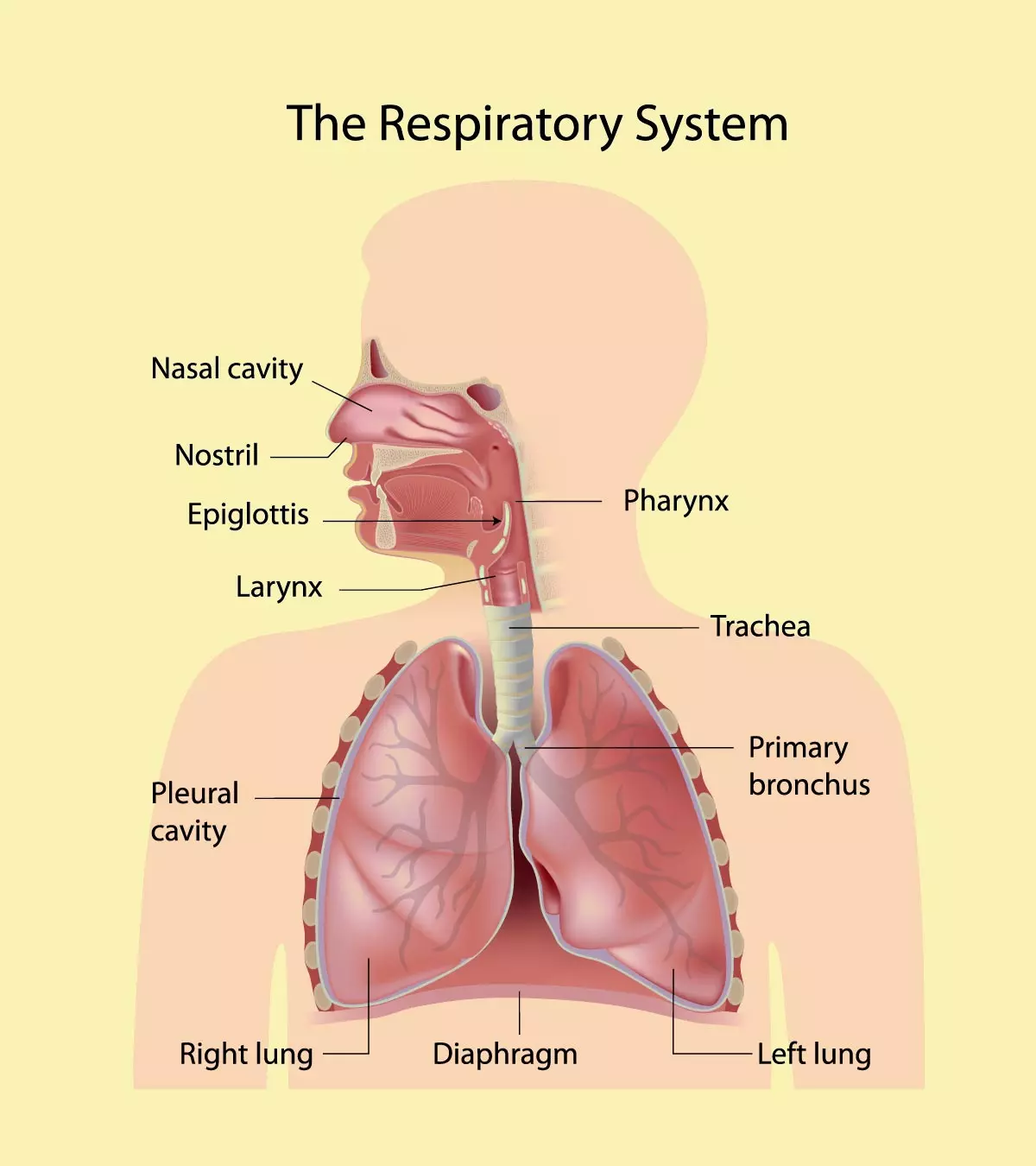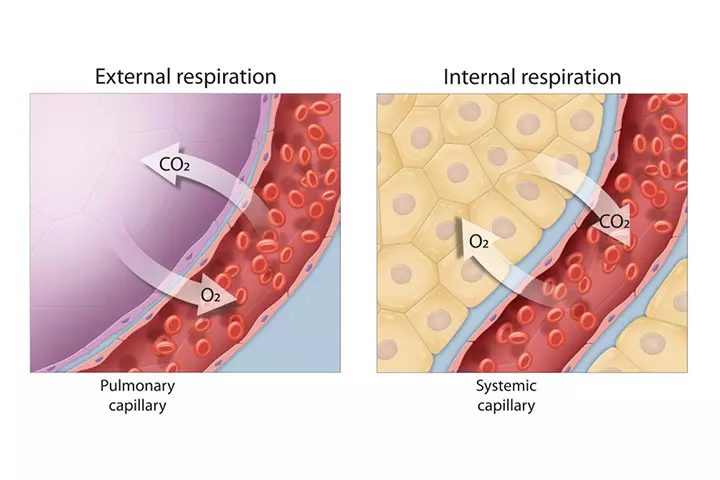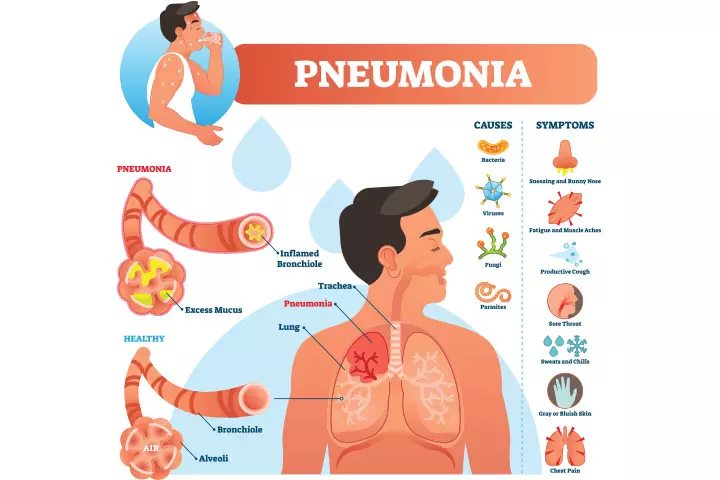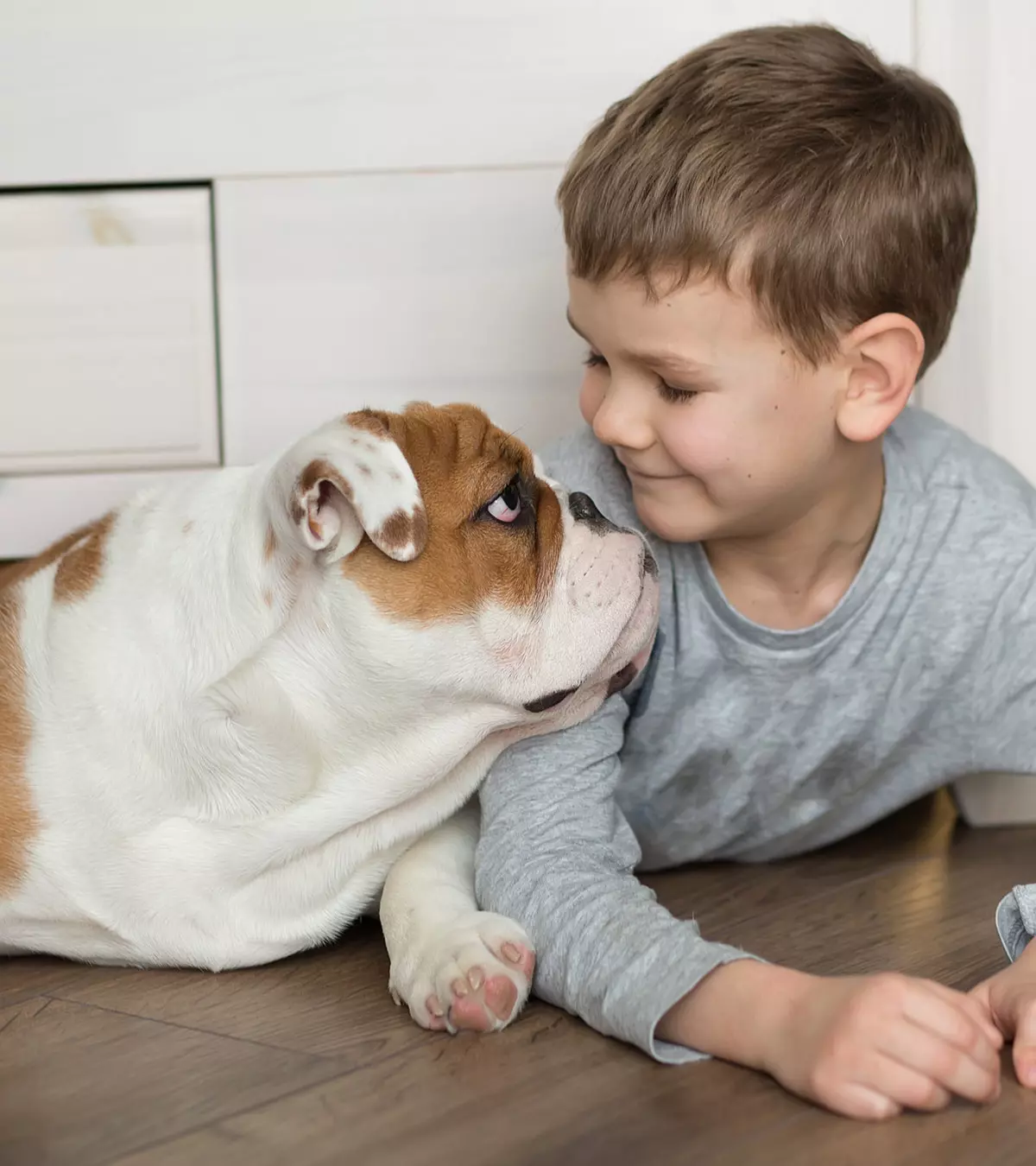
Image: Shutterstock
Explaining the respiratory system for kids may seem easy yet challenging at the same time.

Did you know, several organs form the respiratory system, from the nose to the lungs. Lungs take in oxygen and release carbon dioxide while breathing. Oxygen is needed to perform everyday activities such as moving hands, opening eyes, and digesting food (1).
Humans can survive without water and food for some days, but it is impossible to live more than a few minutes without oxygen. Help your child learn more about the functions and parts of the respiratory system and common illnesses about breathing.
Key Pointers
- Human respiratory system is mainly divided into the upper and lower respiratory tract and lungs.
- Its main functions include air inhalation and exhalation, external and internal respiration, and sound and odor production.
- COVID-19, asthma, pneumonia, and COPD are the most common respiratory diseases. Scroll down for more such facts.
The Respiratory Tract
The respiratory tract is divided into two sections, namely, upper and lower. The part above the voice box or larynx is the upper respiratory tract and the one below it is the lower respiratory tract. The respiratory tract is lined by respiratory mucosa or respiratory epithelium (2). The tract moistens and provides protection from pathogensiMicrobes capable of causing diseases, including bacteria, viruses, worms, protozoa, and fungi. and foreign bodies. Respiratory mucosa helps prevent infection and tissue injury through mucus secretion and the mucociliary clearance actioniA natural defense mechanism of the lung. . The respiratory epithelial layer is replaced with the stratified squamous cell layeriA protective layer present in the outer region of the skin. in the vocal cords of the larynx.
Parts Of The Respiratory System

Upper respiratory tract
The upper respiratory tract constitutes:
- Nose and nostrils: Helps inhale air and exhale the carbon dioxide from the body. The nose consists of two parts, the external nose, which protrudes from the center of the face, and the nasal cavity.
- Nasal cavity: Nasal cavity has an important role in breathing. The nasal cavityis a part that connects with the back of your throat. When you inhale through the nostrils, the air enters through the nostrils and moves through the nasal passages. An important function of the nasal cavity is to warm and humidify the inhaled air.
- Mouth: Acts as a secondary external opening for respiration. The pathway of air entering from the mouth is shorter than the nasal cavity. Unlike the nose, the mouth can neither moisten the air nor filter the air entering the body.
 Did you know?
Did you know?- Pharynx (throat): Allows movement of air from the nose and the mouth to the larynx in the process of breathing. Commonly referred to as the throat, the pharynx is part of both the respiratory and the digestive system of our body. One of the main functions of the pharynx is to warm and humidify the air before it reaches the lungs.
- Larynx: Also called the voice box, the larynx connects the pharynx and the trachea, and also conducts air. If the larynx is completely open, it allows breathing. If it is partially open, then it allows distortion of air, which results in talking, singing, or making sounds. The vocal cords vibrate when air flows over them, thus producing the sound. Larynx also acts as a protective valve that prevents unwanted material from reaching the lower respiratory tract.
Lower respiratory tract
The lower respiratory tract constitutes:
- Trachea: Also called the windpipe, the trachea is a cartilaginousiA structure composed of cartilage (a connective tissue). tube, which connects the larynx and the bronchi. Extending from the larynx, the trachea branches into two primary bronchi, which eventually lead to the lungs.
- Bronchi: These carry the air we breathe into the lungs. Each bronchus branches into smaller tubes called bronchioles that terminate into the alveoli or air sacs in the lungs.
Lungs
Lungs are a pair of pyramid-shaped organs inside your chest
. The primary function of the lungs is to add oxygen to the blood and remove carbon dioxide. This process is called gas exchange or respiration. The various parts of the lungs are:
- Bronchioles: Bronchioles deliver the air to the gas exchanging unit called alveoli. Bronchioles divide into terminal bronchioles, which are the end of the gas conducting system. These are located within the lungs.
- Alveolar ducts: Alveolar ducts are the part of the respiratory passage emerging from bronchioles forming the alveolar sac and alveoli. Alveolar ducts lie within the lungs.
- Alveolar sacs: Alveolar sacs are??tiny air sacs at the end of the alveolar duct within the lungs. Alveoli are the part of the lungs where the gas exchange occurs.
 Did you know?
Did you know?Other parts of the respiratory system
- Pleura: Pleura is a two-layered thin membrane that lines the surface of each lung and the inside of your chest wall. The primary role of the pleura is to provide cushion to the lungs. It also helps in optimal contraction and expansion of the lungs during breathing.
- Thoracic diaphragm: It is the primary muscle used in respiration that helps in inhalation and exhalation. The diaphragm separates the thoracic cavity from the abdominal cavity.
- Rib cage: A set of 24 bones, 12 on each side, which help in the expansion and contraction of the thoracic cavity to facilitate inhalation and exhalation. Another function of the rib cage is to protect the lungs and the heart.
- Intercostal muscles: A group of muscles that run between the ribs and help move the chest wall. Intercostal muscles are involved in the mechanical aspect of breathing, working on expanding and shrinking the size of the chest cavity.
- Cilia: These are tiny hair-like structures that line the respiratory tract. The cilia trap pathogens and other dust particles and push them gradually upwards towards the pharynx.
- Epiglottis: A flap at the entrance of the trachea, which closes when you swallow, keeping food and liquids from entering your airway.
- Sinuses: Hollow spaces in your skull that regulate the temperature and humidity of the inhaled air.
- Pulmonary capillaries: The smallest blood vessels inside the lungs attached to the alveoli are known as pulmonary capillaries.
Functions Of The Respiratory System

- Pulmonary ventilation: The process of inhalation and exhalation of air is called pulmonary ventilation. The changes in the volume and air pressure in the lungs start pulmonary ventilation. During inhalation, the diaphragm and intercostal muscles contract, and the rib cage elevates. The volume of the lungs increases, the air pressure drops, and the air is inhaled. During exhalation, the muscles relax, lungs become smaller, air pressure rises, and the air is exhaled.
- External respiration: The gaseous exchange between the external air and the blood inside the lungs is known as external respiration. Inside the lungs, carbon dioxide is exchanged for fresh oxygen through alveoli. Oxygen is absorbed into the pulmonary capillaries surrounding the alveoli. This oxygen binds with hemoglobiniA protein in the red blood cells that transports oxygen throughout the body. molecules in the red blood cells that flow in the bloodstream. The carbon dioxide from the deoxygenated bloodiOxygen-deficient blood transported through blood vessels, veins to the heart. diffuses from the capillaries into the alveoli and is expelled via exhalation.
- Internal respiration: In this process, the gases are exchanged between the bloodstream and body tissues. Oxygen carried through the blood is delivered to the cells, and carbon dioxide from the cells is carried away by the blood to the lungs for exhalation.
- Sound creation: When we speak, our laryngeal muscles regulate the vocal cords, which vibrate due to the air passing through them. The vibration of the vocal cords creates the sound that we know as voice. Higher tension in vocal cords creates high-pitched voices, and lower tension creates low-pitched voices. Movement of tongue and lips further modifies the quality of voice.
- Smell sensation: A chemical sensation carried to the brain through olfactory nerves. The olfactory fibers, lining the nose, act as receptors. When an odor binds to these receptors, it transmits signals to the olfactory systemiA sensory body system that is responsible for an individual???s sense of smell. of the brain (3).
How Does The Respiratory System Work?
Each inhalation fills the millions of alveoli inside the lungs. Oxygen is diffused into the blood through capillaries. Oxygen gets attached to the hemoglobin, forming oxyhemoglobin in the red blood cells. This oxygen-rich blood flows to the left atrium of the heart. The heart pumps this oxygenated blood, and the arteries carry it to every cell of the body.

The cells produce carbon dioxide as a waste product, and it must be expelled from the body. The carbon dioxide dissolves into the blood that flows through the veins and reaches the right atrium of the heart. From the heart, this deoxygenated blood is pumped to the alveoli of the lungs. The gaseous form of carbon dioxide diffuses from the bloodstream into the alveoli from where it is exhaled out of the body (4).
Common Respiratory Diseases
The following are some of the diseases that affect the respiratory system (5).
- Asthma: A chronic lung disease that inflames and narrows your airways. This causes difficulty in breathing. Common symptoms of asthma include coughing, wheezing, shortness of breath, and chest tightness, among others. Asthma is triggered by:
- Allergic reactions
- Infections
- Pollution
Children with asthma symptoms that are under control can lead normal lives. However, uncontrolled asthma with severe and frequent symptom attacks can significantly affect their lives. As shown in the graph below, the percentage of children with uncontrollable asthma is slightly higher in kids in the 4-11 age group than in younger ones and teens.

Percentage of uncontrolled asthma in children (2018-2025)
Source: Centers for Disease and Control Prevention (CDC)- Pneumonia: The infection of the alveolar sacs causes pneumonia. Pneumonia causes a fluid buildup in the lungs. Usually, patients recover within one to three weeks. Symptoms include cough, fever, chills, and shortness of breath. The causes of pneumonia are:
- Viral infections
- Bacterial infections
- Fungal infections
 Experts say
Experts say- Chronic obstructive pulmonary disease (COPD): It is a progressive inflammatory lung disease. During episodes of COPD, patients experience abnormal inflammation in their lungs and airflow obstruction. Exposure to cigarette smoke and pollution are significant causes of COPD. Symptoms include breathlessness, cough-up sputum, and difficulty in exhalation (6). Emphysema and chronic bronchitis are forms of COPD.

- Lung cancer: Cancer can develop in any part of the lungs. These are difficult to detect and interfere with the normal functioning of the lungs. Chronic coughing, change in voice, harsh breathing sounds, and coughing up blood are some of the symptoms (7).
- COVID-19: It is an illness caused by the SARS-CoV-2 virus, which belongs to the coronavirus family of viruses (8). COVID-19 is highly contagious and spreads through airborne droplets expelled while coughing and sneezing. Cough, fever, and shortness of breath are some of the significant symptoms. Preventive measures include frequent washing of hands and maintaining physical distancing.
- Pleural effusion: In pleural effusion, excess fluid accumulates within the pleural cavity. Reasons can be pneumonia, cancer, or congestive heart failure. Symptoms include chest discomfort and shortness of breath (9).
How To Keep Your Respiratory System Healthy
- Avoid smoking and secondhand smoke as they damage the lungs and increase the risk of respiratory issues.
- Engage in regular exercise such as walking, swimming, or yoga to strengthen lung capacity and efficiency.
- Drink plenty of water to keep mucus membranes moist and ensure proper respiratory function.
- Wash hands frequently to minimize the risk of infections caused by bacteria and viruses (10).
30 Respiratory Fun Facts For Kids
Here are some fun facts about the respiratory system and respiration.
- Left lung is slightly smaller than the right lung.
- Almost 80% of inhaled air consists of nitrogen.
- You can increase your lung capacity by doing regular breathing exercises.
- You can survive with one lung, but it can limit your physical ability.
- Healthy lungs are pink, smooth, and shiny.
- Do you know why we yawn? When there is a low oxygen level in lungs, our brain triggers our body to inhale large amounts of oxygen by yawning.
- We also breathe through our skin, but it accounts for a tiny amount of our respiration.
- We breathe in about 11,000 liters of air every day.
- Hiccups are a result of diaphragm spasmiUncontrollable contraction and twitching of muscles that often causes temporary pain. .
- Irritation to the cilia causes coughing to get rid of the irritation.
- An average adult breathes 12-20 times a minute when at rest.
- Breathing is voluntary as well as an involuntary action.
- The part of the brain that automatically regulates breathing is the medulla oblongata.
- The lungs are the only organs in the human body that can float.
- Lungs cannot expand on their own and require muscles of respiration for inhalation and exhalation.
- Maximum capacity of adult human lungs is 1.5 gallons.
- The diaphragm controls 80% of our breathing.
- Pneumonia has been known to humans for more than 2500 years.

- It is estimated that there are 300 to 500 million alveoli in the lungs of adults.
- To help in gas diffusion, the alveolar sacs are lined with a layer of a watery substance called surfactant.
- A surfactant is produced within the alveoli and prevents them from collapsing while exhaling.
- Males tend to have larger lung capacity than females.
- The total length of airways running through the lungs is about 1,500 miles.
- Our body inhales more often when there is a high carbon dioxide level in the bloodstream.
- Most people breathe only through one nostril at a time.
- The right lung has three lobes, and the left lung has only two lobes.
- Lung capacity gradually diminishes as we grow older.
- Without its C-shaped cartilaginous rings, the trachea (windpipe) would collapse when there is no air within it.
- Inside the mother’s womb, the baby’s lungs are filled with fluid. After birth, it takes 10 seconds for the newborns to breathe.
- The respiratory system facilitates several essential social actions of humans, such as talking, laughing, crying, and singing.
Frequently Asked Questions
1. What is a respiratory system, in simple words, for kids?
The respiratory system is a collection of organs responsible for breathing oxygen and exhaling carbon dioxide in humans.
2. What are the four phases of respiration?
The four phases of respiration include pulmonary ventilation, external respiration, transportation of oxygen and carbon dioxide between lungs and tissues, and internal respiration.
3. What is another name for the respiratory system?
The respiratory system is also called the respiratory apparatus or the ventilatory system.
4. Who named the respiratory system?
The name of the person who coined the term “respiratory system” is unknown, but Marcello Malpighi discovered alveoli and pulmonary capillaries in the lung.
5. What are some fun activities to learn about the respiratory system?
Children can explore the respiratory system through engaging activities like creating a lung model with balloons, performing basic experiments to observe how breathing works, or playing games that focus on deep breathing exercises. These activities make learning about the respiratory system both fun and interactive.
These interesting facts about the respiratory system for kids will educate and entertain them and drive them to explore the subject further. We inhale around 11,000 liters of air in a day, and lungs that are smooth, shiny, and pink are a sign of good respiratory health. Also, the diaphragm controls 80% of breathing, and the lung capacity of males is more than that of females. Share these and other fascinating facts on the respiratory system with your little one and leave them wanting to know more about the human body.
Infographic: Ways To Keep The Respiratory System Healthy
Now you know how these complex and some of the essential organs work non-stop to help us breathe. Therefore, it is vital to take care of them so that they function adequately. Start taking care of your lungs by following the tips from this infographic.
Some thing wrong with infographic shortcode. please verify shortcode syntax
Illustration: Fun And Interesting Respiratory System Facts For Kids

Image: Stable Diffusion/MomJunction Design Team
Explore the amazing Respiratory System! Discover how we breathe and keep our bodies healthy in this educational video made for kids. Perfect for learning and having fun!
References
1. How your lungs work; British Lung Foundation
2. Histology, Respiratory Epithelium; NCBI
3. How We Smell; American Physiological Society
4. How is oxygenated blood different from.deoxygenated blood?; Socratic Q&A
5. CHRONIC RESPIRATORY DISEASES; World Health Organization
6. COPD; Mayo Clinic
7. What is Lung Cancer; American Cancer Society
8. Naming the coronavirus disease (COVID-19) and the virus that causes it; World Health Organization
9. Pleural Effusion; Cleveland Clinic
10. Respiratory System; Cleveland Clinic
11. What Microorganisms Naturally Live in the Mouth?; Dr. Akshima Sahi; Emily Henderson.
12. Advances in Lung Cancer Research; National Cancer Institute.
13. Risk Factors for Pneumonia; CDC
??
Community Experiences
Join the conversation and become a part of our nurturing community! Share your stories, experiences, and insights to connect with fellow parents.
Read full bio of Dr. Anuradha Bansal
Read full bio of Bharathi V
Read full bio of Harshita Makvana
Read full bio of Kavita Kankani
















